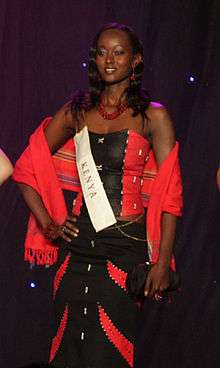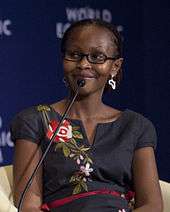Women in Kenya
| |||||||
| Gender Inequality Index[1] | |||||||
|---|---|---|---|---|---|---|---|
| Value | 0.548 (2013) | ||||||
| Rank | 122nd out of 152 | ||||||
| Maternal mortality (per 100,000) | 360 (2010) | ||||||
| Women in parliament | 19.9% (2013) | ||||||
| Females over 25 with secondary education | 25.3% (2012) | ||||||
| Women in labour force | 62.0% (2012) | ||||||
| Global Gender Gap Index[2] | |||||||
| Value | 0.6803 (2013) | ||||||
| Rank | 78th out of 144 | ||||||
The history of the evolution of the traits of women in Kenya can be divided into Women within Swahili culture, Women in British Kenya, and Kenyan Women post-Independence.[3] The condition and status of the female population in Kenya has faced many changes over the past century. The British colonized Kenya from 1888-1963.[4] British imperialism had a large impact on Kenyan culture and still does today. Before British colonization, women played important roles in the community from raising children and maintaining the family to working on farms and in marketplaces. The influence of a patriarchy became even stronger with colonization which stripped women of many responsibilities and opportunities they once had.[5] However, some women such as Mekatilili wa Menza fought alongside men during the struggle for independence and are acknowledged in the country's rich history for their role. Even after Kenya regained independence in 1963, women were still oppressed and not given many opportunities like education except for a small number of young women.[6] Women still faced many problems such as child marriages and arranged marriages, Female Genital Mutilation (FGM), the AIDS epidemic as well as lack of education.[5] Although Kenya still has a long way to go in hearing the plight of women, there continues to be an improvement in financial, social and economic inclusion within the country at different stages ranging from dialogue, policy implementation, representation and so forth.
One such example of the continued development of the lives of Kenyan women exists within the country's growing music and media industry. Muthoni Ndonga, better known as Muthoni the Drummer Queen, has not only pioneered a budding festival culture in East Africa but also built a solid reputation as one of Kenya's leading artists.[7]
Inside Swahili culture
Kenyan women who lived during the Pre-Colonial Era in Kenya were women who existed prior to 1890, which is the period before the arrival of British colonizers. The main functions of women, young and old, were related to farming, child care, maintenance of the household, market vendors, and caring for their husbands, if married.[3]
During British Kenya (1890-1963)
Kenyan women who lived during the period when Kenya was a colony of Britain existed from 1890 to 1963. These women lived in family units that, due to the influence of British colonial institutions, became patriarchal in structure and when cash-crop cultivation were controlled by men.[3]
Missionary opposition to female circumcision
Between 1929–1932, British Protestant missionaries campaigned against the practice of female genital mutilation (FGM), and were met with resistance by the Kikuyu people, Kenya's largest tribe.[8] Lynn M. Thomas, an American historian, writes that during the female circumcision controversy, the issue of FGM became a focal point of the independence movement against British colonial rule, and a test of loyalty—either to the Christian churches of the missionaries, or to the Kikuyu Central Association, the association of the Kikuyu people.[8]
Independent Kenya (1963-)
During the Post-Colonial period, women in Kenya continued to live in a society that has a patriarchal order. When Kenya gained independence in 1963, a few young women were able to attain education because of parents who became involved in religious mission activities since the Colonial era. Many of those who were not able to obtain education in schools, even those who were only 12 years old, were "married off". After 1995, due to the Beijing Platform for Action, many Kenyan women have benefited from the introduction of feminist point of views such as "female consciousness", "confidence as women", "gender equality" and justice for women. Many Kenyan women soon became active participants in Kenyan politics.[3]
Education
The extent of education women received pre-colonization was how to do the jobs women had been doing for years such as wife, caregiver, child birth and housekeeping. Playing this role gave many Kenyan women a sense of identity which most women cherished. During and after colonization, however, educating the youth became more of a commonly accepted idea. Although there was access to education, it was difficult for Kenyan kids, especially girls, to receive a formal education simply because parents did not find it necessary to send their daughters to school. The education that young girls were receiving was similar to that of what they would learn from their mothers pre-colonization. That included skills such as child care and sewing and if the girls were lucky, they would be taught how to read and write. In the late 1900s it became more common for a girl to receive a primary education, but men, on the other hand, were going off to earn degrees and get jobs whereas women were staying at home taking care of the home.[6]
By the 1990s, almost 50% of the students attending primary schools in Kenya were girls. This large jump occurred over time due to Kenya's independence and the development of easier accessible public primary schools throughout Kenya. The Kenyan government has put a larger focus on educating the youth because they believe that it will lead to an overall more prosperous country. According to the Republic of Kenya Embassy's website, they concluded, "...it has been established that by providing primary education to women, a society is able to hasten its development." [9]
The situation for Kenyan girls in secondary school is slightly different than how it was for primary school. At the time of Independence, about 32% of enrollment in Kenyan secondary schools was young women and 68% young men. Over time, those numbers have gone up, but in the most recent studies, it is still 40% to 60% favoring young men attending secondary schools in Kenya. This gap can be explained by the gap between schools available for boys and girls. In 1968 in Kenya, there were 148 government funded primary schools for boys, 61 government funded secondary schools for girls, and 28 co-ed secondary schools funded by the government. Because young men in Kenya have more than twice the number of schools available for them to attend than their female counterparts, many more boys end up going to school because it is easier for them to access secondary schooling. More secondary schools have been built in Kenya since 1968, but that large gap still remains.[6]
Women in Kenyan Politics
More and more women around the world are getting elected into office and the ideas of gender equality and feminism are becoming more widespread. In Kenya, however, women are not getting many decision making roles in the government which further sets women back. Although Kenya is behind in this case, there are a few very influential women who took seats in the Kenyan government.[10]
Following the new constitution in 2010, politics in Kenya took a different turn. There was a shift from the unitary system and structure of government to a decentralized one where authority and responsibility of public functions were redistributed to local governments. The country, therefore, was divided into 47 counties, and each has its own local government, headed by a Governor. It was just in the recently (2017 elections) that women were voted into the Governers seat for the first time. The elected governors were Joyce Laboso for Bomet County, Anne Waiguru for Kirinyaga County and Charity Ngilu for Kitui County.
Wangari Maathai
Wangari Maathai was the first African woman to receive the Nobel Peace Prize for her "contribution to sustainable development, democracy and peace." [11] She was also elected a member of the Kenyan parliament and worked in Kenyan politics for over two decades which was extremely threatening to her male counterparts who she surpassed throughout her time working in the Kenyan Government.[10] Maathai was not directly a feminist activist, but an environmental activist who inspired other women in Kenya and around the world to go into politics and activism.[12] Maathai was also considered to be a "bottom-up" worker as opposed to the "top-down" ruling that Kenya was so accustomed to having for decades past. This was another way she was able to inspire women and other minority groups who were silenced by the government in the past.[13]
Polygamy in Kenya
In March 2014, Kenya's Parliament passed a bill allowing men to marry multiple wives.[14] Polygamy is common among traditional communities in Kenya, as well as among the country’s Muslim community.[14]
In parliament, the proposed 2014 polygamy bill had initially given a wife the right to veto the husband's choice, but male members of parliament overcame party divisions to push through a text that dropped this clause.[14] The passing of the bill caused angry female members of parliament to storm out of the late night vote on the polygamy legislation in protest.[14]
See also
Further reading
- Couillard, Valérie (December 2007). "The Nairobi Declaration: redefining reparation for women victims of sexual violence". International Journal of Transitional Justice. Oxford Journals. 1 (3): 444–453. doi:10.1093/ijtj/ijm030.
References
- ↑ "Table 4: Gender Inequality Index". United Nations Development Programme. Retrieved 7 November 2014.
- ↑ "The Global Gender Gap Report 2013" (PDF). World Economic Forum. pp. 12–13.
- 1 2 3 4 Gatwiri Kariuki, Claris. "WOMEN PARTICIPATION IN THE KENYAN SOCIETY" (PDF). Issue 296 December 22– 28, 2010. The African Executive. Retrieved 5 November 2013.
- ↑ Bates, Francesca (January 19, 2015). "British Rule in Kenya". Washington State University. Retrieved March 9, 2017.
- 1 2 Gatwiri Kariuki, Claris (December 22, 2010). "WOMEN PARTICIPATION IN THE KENYAN SOCIETY" (pdf). The African Executive.
- 1 2 3 Karani, Florida. "The Situation and Roles of Women in Kenya". The Journal of Negro Education. 53: 422–434. JSTOR 2295235.
- ↑ Werman Marco (2016-01-07). "Muthoni the Drummer Queen Rules Kenya's Music Scene". PRI.
- 1 2 Thomas, Lynn M. "'Ngaitana (I will circumcise myself)': Lessons from Colonial Campaigns to Ban Excision in Meru, Kenya", in Shell-Duncan, Bettina and Hernlund, Ylva (eds). Female "Circumcision" in Africa. Lynne Rienner, 2000, p. 129ff.
- ↑ "Education in Kenya".
- 1 2 Kamau, Nyokabi (2010). "Women and Political Leadership in Kenya" (PDF). East and Horn of Africa – via Henrich Böll Stiftung.
- ↑ "The Nobel Peace Prize in 2004". The Nobel Prize. October 8, 2004.
- ↑ Presbey, Gail M. (29 November 2013). "Women's empowerment: the insights of Wangari Maathai". Taylor and Francis Online.
- ↑ Dennehy, Kevin (September 12, 2013). "A Greener Africa: Learning from The Legacy of Wangari Maathai". Yale School of Forestry and Environmental Studies.
- 1 2 3 4 "Kenya's parliament passes bill allowing polygamy", The Guardian, 22 March 2014.
External links
| Wikimedia Commons has media related to Women of Kenya. |
- HISTORY OF FEMINISM IN KENYA
- Kenya: The War on Kenyan Women by Ann Njogu, 30 January 2009
- National Council of Women of Kenya by Alistair Boddy-Evans
- AFRICAN WOMANHOOD IN COLONIAL KENYA, 1900–1950 — 2000 by Tabitha Kanogo
- Gender Equity Issues in Kenya
- The history of women and gender in Kenya
- Personalities, Kenya History — Makers of a Nation







.svg.png)